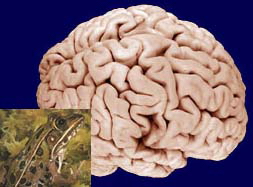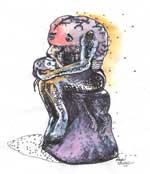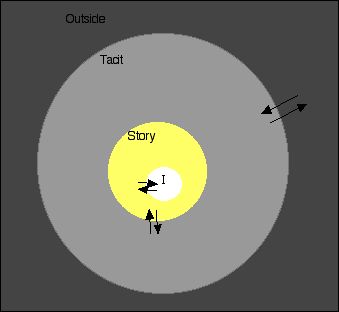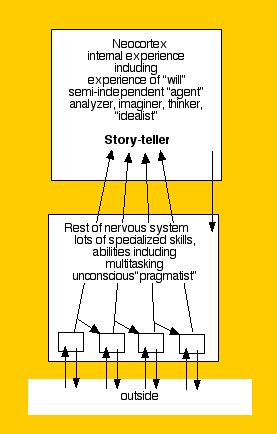Serendip is an independent site partnering with faculty at multiple colleges and universities around the world. Happy exploring!
Brain Behavior Institute - Session 15
|
|
 |
BRAIN AND BEHAVIOR INSTITUTE 2009Session 15 |
 |
From the Input Side to Story
Everything you have been discussing about how the brain works, the box in the box, and emergent learning is displayed in what the scientists at NASA are doing. Creatively, they have envisioned things and perceived things as they would be but aren't yet! ... Judith
If just once while Paul was banging on the table and asking, "What is this?" his hand passed smoothly back and forth through the table----would any of us be at all surprised at this point? For me there is something really exciting about bumping up against my presumptions and discovering a whole new "playground" for the mind ... Deb
We love to be tricked, fooled, have our emotions strung out as long as we land solidly on our feet after disembarking the ride ... Joyce
One of the most enjoyable lessons I implemented during a summer forensics program, each student had to become an eyewitness ... We began to realize that many of us had constructed what was real to us and we even filled in what was missing in our mind ... Many of the students were surprised in the assumptions they made and how incorrect they could be. We could all use an exercise like this to show how no one is completely right or wrong and how our brain can/will change a story to fit our experiences or view points ... Kathy
Why has Paul devoted all the time and energy (two sessions worth) to the senses? Is it simply to once again shatter my understanding of the world? To once again examine my assumptions? I already have accepted that everything I thought I knew is open for question. I have also accepted the idea that the brain constructs our reality. I'm still searching for a new understanding or a new story to emerge from these two days of work ... Jill
The balance of stories model avoids both extremes and aims to keep alive throughout the class the exictement and openess with which the teacher and the students come to it ... Bharath
 What you see isn't what's "out there"; its an "informed guess" made by your cognitive unconscious based on presumptions there about what is important to you.
What you see isn't what's "out there"; its an "informed guess" made by your cognitive unconscious based on presumptions there about what is important to you.
Different people see (hear/smell/taste/etc) different things
Your nervous system can respond to things without seeing them (blindsight). Hence perceiving, like action, reflects a bipartite brain - "Consciousness" is not only an "I-function" but a more general "story teller"
Story of "I" allows you to do things you couldn't other wise do
Self as object in bigger world
Story of "outside there" allows you to conceive alternatives
 Ambiguity, "crack" in bipartite brain, gives one "agency" - Enhance agency by developing the skill of withholding judgement, conceiving alternatives - That the point of an emergent classroom?
Ambiguity, "crack" in bipartite brain, gives one "agency" - Enhance agency by developing the skill of withholding judgement, conceiving alternatives - That the point of an emergent classroom?
For the forum area ... thoughts about ambiguity, agency, parallels between brain organization and experiences in the classroom?




Comments
Another Link Paul
Ambigous
New illusion
New illusion based on age and experience
The Next Morning
My As I continue to think of how my understanding of the brain and how it effects learning inside and outside of the classroom, I am reminded of the quote V.S.Ramachandran, 2003: " it never ceases to amaze me that all the richness of our mental life - all our feelings, our emotions, our thoughts, our ambitions, our love life, our religious sentiments and even what each of us regards as his own intimate private self - is simply the activity of these little specks of jelly in your head, in your brain. There is nothing else" The idea of jelly in the head makes me think of emergence as ‘Jello’. With powder, hot water and lots or stirring, different level flavors, shapes and consistencies can develop at different times.
I am beginning to be more comfortable with the continual process of making connections, and emerging into who I am becoming.
It's all indoctrination
"Teaching students to a adopt a particular methodology as an approach to thinking about the world is in some sense indoctrination." (Bob Hazen)
Does the methodology end or begin questioning?
One of my students is at a camp in the Poconos right now. This camp is not a Quaker camp and they do gather for the Pledge of Allegiance each day. The student is not accustomed to this ritual, having been educated in a Quaker school for the last eight years. In a very real sense he has been indoctrinated by Quaker educational philosophy and practice. He can react in a variety of ways. It is possible that he'll join in saying the pledge, maybe he'll get anxious about the time he has to gather with everyone else for the pledge, maybe he won't say the pledge in a knee jerk reaction, or maybe he'll have a little talk with himself about why he chooses to or not to say the pledge. Maybe that talk will extend to others and he'll hear why others do or don't join in this ritual. Life is a naturally emergent process.
Paths
Last night, I could not manage a conversation with myself. This morning as I walked from the train to campus, I ran into myself and had a delightful exchange. I've enjoyed walking the Bryn Mawr campus on the way to our sessions every day. It occurred to me today that I've been staying on the paths. I also noticed that due to the construction on campus, each day the available paths have been slightly different--there is nothing like a mad orange construction barrier to make you change your direction. Paul throws out orange barriers in the institute all of the time---he also sends out flares, as do fellow participants, that draw my attention and direction. What gets any of us off the path so to speak? In thinking about the projects we are working on, we've got agency to choose our own paths--still we are trodding worn paths--otherwise we wouldn't find any related research to link to our ideas. So, at what point in the project do we leave the path? Is it when a big orange blockade keeps us from pursuing a particular path? Is is when we meet ourselves and have a delightful conversation that shifts our perspective? What motivates some people to live their lives off the path---inventing new possiblities, approaches, realities? Is it important to return to the path? How often and for what purpose?
Story Telling
My last day at Nasa; they took us to the real interworkings of Nasa; the television room and the editing and video making room. They wanted us to see objects that are in space or (their perception) of what is in space. They wanted us to see them orchestrate them into a symphony of beauty which we would pass on to our students. This made me wonder what is really out there; is it all made up by my brain? They also encourage people to use these services to get a better awareness of what is out in space. Our perception of things plays a very important part of how they get funded. Changing perceptions can be very affective or can it?
Again, the brain is a very complex box inside of box that sometimes fools us!
thinking differently
In the beginning of each school year I spend some time on working together. First and foremost in the lesson is that each student should do their share. That usually extends into everyone has something to offer to the group because we all have different life experiences. I really try to push the idea home that no one person is smarter than the others and spend quite a bit of time giving “wait time” for questions. I am always amazed how often one student in the group will grasp a concept and will be right on the mark but their peers will not listen. I usually will stand with the students at that point and say, “Are you listening to your lab partners?” I never say that the partner is correct. Some students catch on fairly quickly others take a while but eventually they start to listen and are quite successful. I enjoyed this mornings ambiguous figures and decided how useful the visual aids will be for my students. I have started developing a whole new lesson plan to incorporate the ambiguous figures section into the beginning of the year. Afterwards, I also have decided to take a different image each time we do a lab or group work and displaying it as a warm up board to remind students that we all have different ways of looking that can all be correct. Hopefully the warm ups will remind them most so I have to less ;-).
Ambiguity
I thoroughly enjoyed this session. I never thought of how my brain sees things and another person sees the same thing either real or filled in. So now I know that when I coach a singer, the "let's try it my way" is not necessarily being confrontational but actually opening another door, and I'm fine with that. Thanks Paul we're progressing.
Agents of Change
FIRST-
"We help students develop skills to take apart what they see and put them back toigether. We want our students to know that they have abilities within themselves to open up new alternative ways to think about things." So we are creating tools that help students scaffold what we're teaching them.
Are students in suburban disricts more like sponges that soak up what's being thrown their way? Many of the inner city students I taught for the past three years liked science, but did not seem interested in learning science, but many did enjoy doing science. I was trying to be their "guide on the side" and they became my emergent learners. Students seemed excited about science, but not committed to staying focused on my lessons.
SECOND-
Perception is influenced by genetics and experience. I honestly think my mother gave me the ability to look at things from a warped angle. Maybe I inherited this or maybe i learned it from watching her. Either way, we both look at things from nature and make faces out of the angles. Now I am wondering- do sculptors see things like that too? Does anyone else see faces when they look at the pipes under sinks or in the designs of urinals? Is there more matter (than in other folk) in my (part of the) brain that contains images?
Perception of Faces
Hi Jack,
Is it really warped to 'see' faces in objects? In a social context, it is natural look at and examines faces for various reasons. The poster of "Everyone has feelings" demonstrates that in the way we recognize faces and internally assign meaning to the faces as we see them.
As the story continues...
Yesterday, during lunch, I was engaged in an interesting discussion about why is the school year ten months. Why is the expectation of educators and students that we cram so much information into ten months? Would schools be better served if the school year were longer, allowing more time for open ended transactional inquiry? What would happen if as educators’ we said “NO” to standardized testing, and validated other methodologies for assessing student achievement, learning and effective classrooms??????
What could happen if we perceived the purpose of education to produce lifelong searchers of the their own path, instead of young adults who are prepared to continue more years of regurgitating someone else’s information?
Do I really care if my mechanic is able to conjugate verbs in German better than 90% of his or her peers? No, I just want to know if they are able to accurately diagnose my car, and fix it quickly, accurately and at a price point for which I will not have to re-finance my life to continue to operate my vehicle safely.
As I continue to become a better master of my craft: assisting special education students to be able to make relevant meaningful connections to their world and the academic world. I am continually trying to make sense of the current pedagogy, research and intuition and to help my students do the same thing.
Wil, Paul, Emily and I
Wil, Paul, Emily and I actually had a long discussion about implications of schools teaching toward lifelong learning rather than regurgitation and lack of learning in life. We'd love to have your ideas about it, here's the link.
What is reality?
As children, we make up all kinds of unique stories as to the origins of different things. As we gain more experiences, we readily change our perceptions...(monsters in the closet- make noises). As adults, we are more reticent to change our perceptions. Maybe we should be more like children.
Another thought... what is reality now, especially new technology was at one time in the past, in the mind of a person. We have cell phones as a result of someone's imagination in the past. What then is reality?????
Post new comment